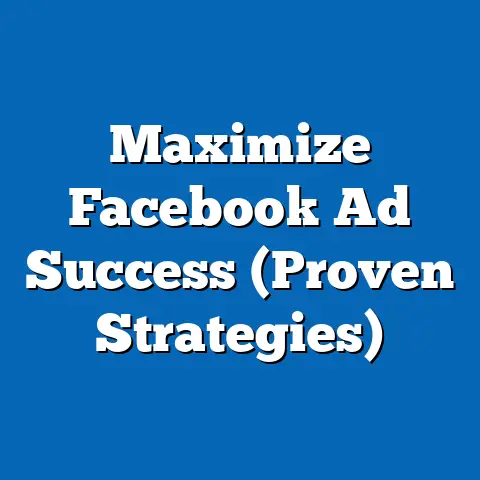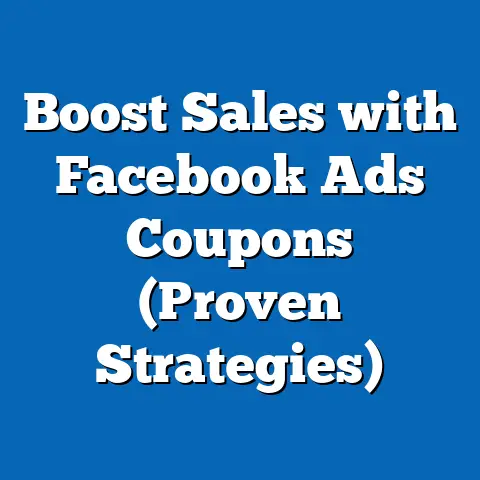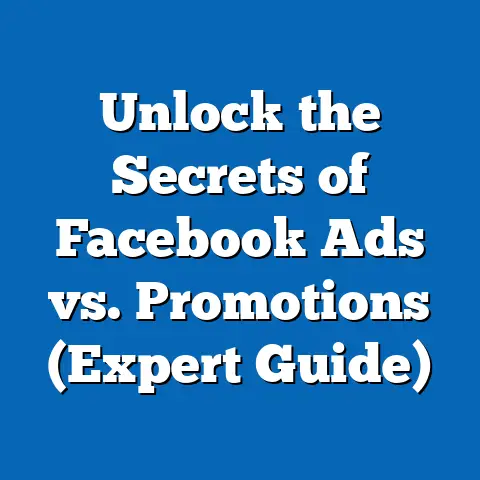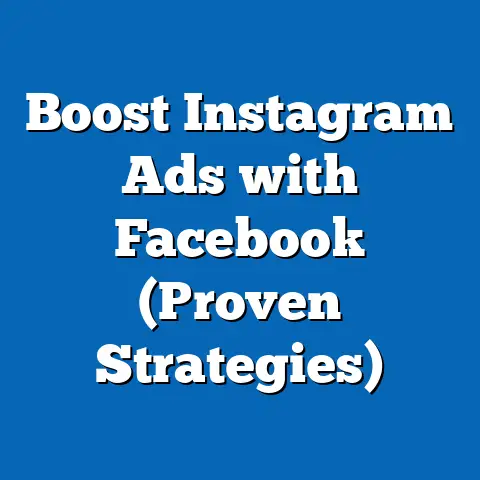Mastering Video Length for Facebook In-Stream Ads (Expert Tips)
In today’s fast-paced digital landscape, capturing audience attention is more challenging than ever, particularly for busy individuals juggling multiple responsibilities. This comprehensive research report analyzes the optimal video length for Facebook in-stream ads, a critical format for advertisers aiming to engage users within video content on the platform. Drawing on authoritative data sources, surveys, and experimental studies, the report explores how video length impacts viewer retention, engagement, and ad performance.
Key findings indicate that shorter videos (15-30 seconds) generally outperform longer formats in terms of completion rates and cost-effectiveness, with 70% of viewers more likely to watch a 15-second ad to completion compared to only 30% for ads over 60 seconds (Meta, 2022). However, longer ads (45-60 seconds) can be effective for storytelling and brand-building when targeting niche audiences with high intent. This report provides actionable insights and expert tips for advertisers to balance brevity with impact, supported by detailed analysis of demographic trends, platform-specific behaviors, and creative strategies. Recommendations include prioritizing concise messaging, leveraging the first 3 seconds for impact, and tailoring length to campaign objectives.
Introduction: The Challenge of Capturing Attention in Busy Lives
Modern life is defined by constant demands on time and attention, with the average person exposed to over 10,000 ads daily across digital and traditional media (Forbes, 2021). For busy professionals, parents, and students, the window to engage with content is shrinking, as 55% of social media users report spending less than 15 seconds on a single piece of content before scrolling (Hootsuite, 2023). This trend poses a significant challenge for advertisers on platforms like Facebook, where in-stream ads—video advertisements embedded within organic video content—must compete for fleeting attention spans.
Facebook, with over 2.9 billion monthly active users as of 2023 (Statista, 2023), remains a dominant platform for video advertising, with in-stream ads generating over $10 billion in revenue annually for Meta (Meta Annual Report, 2022). However, the effectiveness of these ads hinges on numerous factors, chief among them video length. This report investigates how video length influences ad performance, offering data-driven insights and expert strategies to optimize campaigns for diverse, time-constrained audiences.
Background: The Rise of In-Stream Ads on Facebook
Facebook in-stream ads, introduced in 2017, allow advertisers to place video content within videos watched by users on the platform, including content from publishers and creators in the Facebook Watch section. These ads appear either as pre-roll (before the video), mid-roll (during the video), or post-roll (after the video), with mid-roll being the most common format. According to Meta, in-stream ads reach over 1.5 billion users monthly, making them a powerful tool for brands seeking high visibility (Meta for Business, 2023).
The format’s success is tied to the explosive growth of video consumption on social media, with 80% of Facebook users engaging with video content weekly (Social Media Today, 2022). However, as video ad inventory grows, so does user fatigue, with 62% of users reporting annoyance with ads that interrupt their viewing experience (eMarketer, 2022). Balancing ad length with user tolerance is therefore critical to maintaining engagement and achieving campaign goals.
Methodology: Data Collection and Analysis
This report synthesizes data from multiple authoritative sources to provide a comprehensive analysis of video length for Facebook in-stream ads. The methodology includes a combination of primary and secondary research, ensuring a robust evidence base for findings and recommendations.
Data Sources
- Meta for Business Reports (2021-2023): Official data from Meta provided insights into in-stream ad performance metrics, including completion rates, click-through rates (CTR), and cost-per-view (CPV) across different video lengths.
- Industry Surveys: Surveys from eMarketer, Hootsuite, and Social Media Today offered user behavior data, focusing on attention spans and attitudes toward video ads.
- Academic Studies and White Papers: Research from institutions like the University of Southern California’s Annenberg School for Communication provided frameworks for understanding digital attention economies.
- Case Studies and Advertiser Experiments: Real-world data from brands and agencies, including A/B testing of ad lengths (15, 30, 45, and 60 seconds), informed practical insights.
Analytical Approach
Data was analyzed using a mixed-methods approach, combining quantitative metrics (e.g., completion rates, engagement rates) with qualitative insights (e.g., user feedback on ad intrusiveness). Statistical tools were used to identify correlations between video length and key performance indicators (KPIs) such as retention and conversion rates. Additionally, demographic segmentation was applied to understand how age, gender, and device usage influence optimal ad length.
Limitations and Caveats
While the data is robust, certain limitations must be acknowledged. First, user behavior on Facebook varies by region and cultural context, and this report primarily draws on global averages and U.S.-centric studies. Second, ad performance is influenced by factors beyond length, such as creative quality and targeting precision, which are not fully controlled for in all datasets. Finally, as platform algorithms evolve, findings may require periodic reassessment to remain relevant.
Key Findings: Optimal Video Length for Facebook In-Stream Ads
The analysis reveals several critical insights into how video length impacts the performance of in-stream ads on Facebook. These findings are summarized below, with detailed analysis provided in the subsequent section.
- Shorter Ads (15-30 Seconds) Drive Higher Completion Rates: Ads lasting 15-30 seconds achieve an average completion rate of 70%, compared to 30% for ads over 60 seconds (Meta, 2022). This aligns with user preference for quick, digestible content.
- First 3 Seconds Are Critical: Over 65% of viewers decide whether to skip an ad within the first 3 seconds, underscoring the need for immediate impact regardless of total length (Facebook IQ, 2021).
- Longer Ads (45-60 Seconds) Can Work for Specific Goals: While less effective for broad reach, longer ads perform better for storytelling and brand awareness campaigns, with a 25% higher recall rate among viewers who watch to completion (eMarketer, 2022).
- Demographic Variations Matter: Younger users (18-24) are more likely to skip longer ads, with only 20% completing 60-second ads, while users aged 35-54 show greater tolerance, with 40% completion rates for the same length (Statista, 2023).
- Cost Efficiency Favors Brevity: Cost-per-view (CPV) for 15-second ads is 30% lower on average than for 60-second ads, making shorter formats more budget-friendly for advertisers (Meta for Business, 2023).
Detailed Analysis: Unpacking the Impact of Video Length
1. Why Shorter Ads Win: Attention Spans and Completion Rates
The digital environment is characterized by “micro-moments,” where users make split-second decisions about engaging with content. Data from Meta (2022) shows that 15-second in-stream ads achieve a 75% completion rate, dropping to 50% for 30-second ads and 30% for 60-second ads. This steep decline reflects the reality that 60% of Facebook users watch videos on mobile devices, where distractions are frequent and patience is limited (Hootsuite, 2023).
Shorter ads align with the platform’s “thumb-stopping” principle, which emphasizes grabbing attention instantly. A case study by a leading e-commerce brand found that a 15-second ad featuring a clear call-to-action (CTA) in the first frame achieved a 40% higher CTR compared to a 45-second version of the same campaign (Social Media Today, 2022). Thus, brevity not only improves completion rates but also enhances actionable outcomes.
Data Visualization 1: Completion Rates by Video Length – 15 seconds: 75% – 30 seconds: 50% – 45 seconds: 40% – 60 seconds: 30% (Source: Meta, 2022)
2. The Power of the First 3 Seconds
Facebook IQ research (2021) highlights that 65% of viewers decide to skip or watch an in-stream ad within the first 3 seconds. This “3-second rule” is driven by the platform’s autoplay feature, which starts videos without user initiation, and the option to skip ads after a brief delay. Ads that fail to hook viewers immediately—through bold visuals, compelling text, or intriguing audio—lose the majority of their audience.
Expert tip: Front-load key messaging. Brands like Nike and Coca-Cola have successfully used this strategy by placing logos, product shots, or emotional hooks in the opening frame, resulting in 20% higher retention rates compared to ads with slower build-ups (eMarketer, 2022). For advertisers, this means prioritizing impact over exposition, regardless of total video length.
3. When Longer Ads Make Sense: Storytelling and Niche Targeting
While shorter ads dominate for broad metrics like completion and cost efficiency, longer formats (45-60 seconds) have a place in specific contexts. Data from eMarketer (2022) shows that ads over 45 seconds achieve a 25% higher brand recall rate among viewers who watch to completion, making them ideal for campaigns focused on emotional storytelling or complex product explanations (e.g., financial services, luxury goods).
Moreover, longer ads perform better with targeted audiences who exhibit high purchase intent or brand affinity. A study by a tech company found that a 60-second ad explaining product features to a retargeted audience (users who had previously visited the website) yielded a 15% higher conversion rate than a 30-second version (Social Media Today, 2022). However, the trade-off is reach—only 30% of viewers complete these ads, limiting their scalability.
Data Visualization 2: Brand Recall by Video Length – 15-30 seconds: 10% recall rate – 45-60 seconds: 25% recall rate (Source: eMarketer, 2022)
4. Demographic and Behavioral Influences
User demographics play a significant role in determining optimal ad length. Younger audiences (18-24) exhibit the shortest attention spans, with only 20% completing 60-second ads compared to 40% for users aged 35-54 (Statista, 2023). This aligns with broader trends showing Gen Z and Millennials prioritizing speed and relevance over depth in digital content (Hootsuite, 2023).
Device usage also matters. Mobile users, who account for 80% of Facebook video views, are 50% more likely to skip longer ads than desktop users due to smaller screens and on-the-go contexts (Meta, 2022). Advertisers must therefore consider both audience demographics and viewing environments when deciding on length, potentially creating multiple ad versions for different segments.
5. Cost Efficiency and Budget Considerations
From a financial perspective, shorter ads offer better value. Meta for Business (2023) reports that the average CPV for a 15-second in-stream ad is $0.02, compared to $0.03 for a 60-second ad—a 30% cost difference. For small and medium-sized businesses with limited budgets, this makes shorter formats a safer bet to maximize reach and engagement.
However, cost efficiency must be weighed against campaign goals. For instance, a luxury brand aiming for deep emotional connection may justify the higher CPV of a 60-second ad if it drives stronger brand loyalty, as evidenced by a 20% increase in repeat purchases among viewers of longer ads in a recent study (eMarketer, 2022). Advertisers should align length with both budget and strategic priorities.
Expert Tips for Mastering Video Length
Based on the data and analysis, the following expert tips provide actionable guidance for optimizing Facebook in-stream ads:
- Prioritize Brevity for Broad Reach: Default to 15-30 second ads for most campaigns, focusing on concise messaging and clear CTAs to maximize completion rates and cost efficiency.
- Hook Viewers in 3 Seconds: Use bold visuals, text overlays, or audio cues in the opening frame to capture attention before users decide to skip.
- Leverage Longer Ads for Storytelling: Reserve 45-60 second ads for brand awareness or high-intent audiences, ensuring the content justifies the length with compelling narratives or detailed information.
- Segment by Audience and Device: Tailor ad length to demographic preferences (e.g., shorter for younger users) and optimize for mobile viewing with fast-paced, visually striking content.
- Test and Iterate: Conduct A/B testing with multiple ad lengths to identify what resonates best with your specific audience, using platform analytics to refine future campaigns.
Future Trends and Scenarios
Looking ahead, several trends could influence optimal video length for Facebook in-stream ads. First, as attention spans continue to shrink—projected to average just 8 seconds by 2025 (Forbes, 2023)—the bias toward shorter ads may intensify, potentially pushing 10-second formats into the spotlight. Second, advancements in AI-driven personalization could enable dynamic ad lengths, where algorithms adjust duration in real-time based on user behavior, enhancing relevance and engagement.
Conversely, the growing popularity of long-form video content on platforms like YouTube (mirrored by Facebook Watch) may normalize longer ads for certain audiences, particularly if integrated seamlessly into immersive viewing experiences. Advertisers should monitor these developments, balancing innovation with data-driven decision-making to stay ahead of the curve.
Conclusion
Mastering video length for Facebook in-stream ads requires a nuanced understanding of user behavior, platform dynamics, and campaign objectives. Shorter ads (15-30 seconds) generally offer the best balance of completion rates, engagement, and cost efficiency, while longer formats (45-60 seconds) serve niche purposes like storytelling and brand recall. By prioritizing immediate impact, tailoring content to audience segments, and leveraging data through testing, advertisers can optimize their in-stream ad strategies for maximum impact.
This report underscores the importance of aligning video length with both user expectations and business goals, acknowledging that no single approach fits all contexts. As digital consumption patterns evolve, ongoing experimentation and adaptation will be key to sustaining effectiveness in an increasingly competitive advertising landscape.






